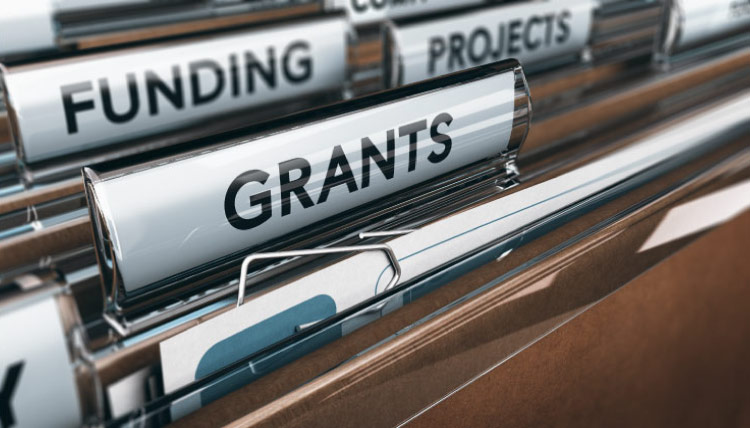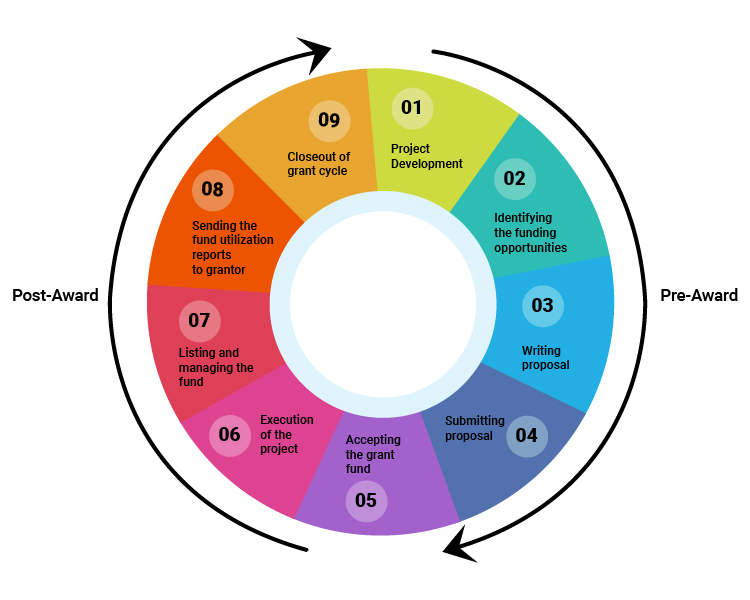Grant Management
Everything you need to know about grant management, presented by Replicon, the Time Intelligence® platform

- What Is Grant Management?
- Grantmakers vs. Grantseekers
- Why Is Grant Management Crucial?
- Grant Lifecycle and Management
- Grant Management Lifecycle for Grantmaker and Grantseeker
- How Do Grantseeker Typically Manage the Grants
- Tracking Time Against Grants
- Grant Management Best Practices for Grantseekers
- What Is Grant Management?
- Grantmakers vs. Grantseekers
- Why Is Grant Management Crucial?
- Grant Lifecycle and Management
- Grant Management Lifecycle for Grantmaker and Grantseeker
- How Do Grantseeker Typically Manage the Grants
- Tracking Time Against Grants
- Grant Management Best Practices for Grantseekers
A grant is a provision of money to a non-profit organization for fund-worthy, value-creating projects. The grant process is a linear lifecycle carried out by the grantmaker and the grantseeker. It flows from the grantmaker creating a grant funding program to the grantseeker applying for that grant. In the end, it culminates with the grantmaker awarding a grant to the selected non-profit organization or business.
The leaders of non-profit organizations (NPOs) – the grantseekers – undertake the time-consuming task of searching for appropriate grants and completing grant applications, all while keeping their records up to date. However, leaders have found that grant management software tools help streamline this complex process.
Below is a detailed guide to the grant management process that includes some useful tips on how to execute it successfully.
What Is Grant Management?

Grant management is a process that is used by a grant-making organization/grantors to distribute grant funds to non-profits or small businesses. The process requires a lot of work-intensive tasks, ranging from creating a grant program, selecting worthy applicants, distributing money, to collecting reports from grantees.
Grant process is a linear lifecycle that requires one phase to complete before moving on to the next one. However, the grant management cycle operates differently for the grantseeker (the NPO that uses the grant) and the grantmaker (the organization that distributes grants and awards funds). It encompasses several stages: creating the grant, assessing the applications, choosing the worthy applicant, awarding the grant fund, and periodically analyzing whether the fund is being used in an appropriate manner.
For a grant seeker, it is an administrative process that requires using the grants and fulfilling the requirements of the grant for a specific period, starting from applying for a grant, managing the grant fund, to sharing timely reports with the grantor, and more. However, as a grantmaker, the more effectively you manage the grants, the more your organization can contribute to projects and issues that matter to you. Thus, grant management facilitates grantmakers to allocate funds to meaningful projects that serve corporate purposes.
Grantmakers vs. Grantseekers
Grantmakers and grantseekers play complementary roles in the grant process; however, their roles in this cycle are quite interdependent.
A grantmaker works for the government or foundations and is responsible for managing grant programs. They are the funders who solicit applications and select worthy applications after thorough evaluation. Their primary tasks revolve around creating grant programs, setting strategic goals, accepting applications from grantseekers, assessing applications, and awarding grant funds to worthy applicants. Moreover, the grantmakers also look into the reports after disbursing the fund to check if the awardee is using the money appropriately, while clinging to the guidelines of the agreement.
On the other hand, a grant seeker is typically an NPO(non-profit organization) or its representative who seeks grants to achieve the goals of their NPO. Generally, these non-profits have diversified sources of revenue and try to receive money from more than one funding source. Grantseeker tasks include gathering internal information, searching the grant opportunities that match their needs, understanding the qualifying and eligibility criteria of grant programs, and finally, applying for grants by writing the application or proposal. While grantseekers are often NPOs, they can also be small businesses sometimes.
Why Is Grant Management Crucial?
For grantmakers, it is a huge responsibility to realize the grant process from inception till the end of the lifecycle. They have to manage grant logistics, coordinate communications and pursue administration work. Therefore, an organized grant process is vital so that they can distribute the fund effectively to the worthy organization or NPO. Diligent grant management can help in the smooth execution of the grant project, saving the grant makers from faulty accounting, misspent funds, or losing track of progress. In addition, appropriate grant management ensures that the grants are created with proper guidelines so that only relevant applications are received.
In the case of grant-seekers, if they have only one or two grants, then managing those funds and fulfilling the grant requirements are easy. However, most NPOs apply for multiple grants at the same time and juggle associated responsibilities simultaneously. Therefore, managing various grants, such as submitting proposals on time, sending out reports to grantors, and keeping a tab on every grant’s progress, requires a good deal of time and effort. Therefore, it is important to have a grant management process so that grant-seekers can stay on top of their every great funding opportunity.
Grant Lifecycle and Management
The lifecycle of a grant comprises of three phases:
1. The Pre-award Phase
This phase involves all the activities that take place before the grant awardee is selected. Before understanding this phase, let us understand the roles of the grantmaker and grantseeker individually in this phase.
Grantmaker: The grantmaker creates a new grant program and establishes its strategic goals. The grant may target a specific field, such as arts and culture, education, or healthcare domain. The grantmaker must clearly spell out their grant program objectives, so they only attract applications from qualified grantseekers.
Grantseeker: Grantseeker starts searching for grant opportunities that can fulfill their organization’s objective. Once the grant seeker comes across a relevant grant, they have to follow various steps, including collecting internal information, understanding the eligibility criteria, and finally moving to the process of applying for that grant.
The Pre-award Phase Includes Three Primary Steps
Step 1
Grantseekers collect internal information prior to searching for the specific grant, like:
- What is the objective of the funding
- How will the grant help them achieve their non-profit goals
- Which of their projects requires funding, and how much revenue do they need
- What will be the size of the team that will be working on this project
Step 2
Once they clearly understand their needs, grantseekers start searching for suitable grant opportunities using the grant database and assessing which ones they are eligible for and which match their requirements.
Step 3
Once they’ve found the grant program that aligns with their needs, grantseekers write a grant application or proposal, being sure to include all necessary details (required revenue, qualifications, etc.), and send the application to the grant program representative. Writing the grant application is the most important step, as it can make you stand out among other applications. Grantseekers should convey how the fund will be utilized to meet their objective and the positive impact it will create.
2. The Award Phase

Once the grantseeker has applied for the grant, the award phase begins.
Grantmaker- In this phase, the grantmaker thoroughly analyzes all the applications and selects the grantee with the strongest grant application that best uses their grant fund. The funder rewards the grant to the awardee.
Grantseeker(Awardee)- Before getting awarded funds, the selected award recipient is given an agreement that outlines the grant’s terms and conditions, including grant policies, how the funds must be used, team size requirements, timelines, and any other requirements of the grant. This agreement helps ensure that the grant’s execution will be frictionless. Once the grantseeker reviews the agreement, both the awardee and funder sign it off. The awardee should communicate to the whole team the expectations, policies, and deadlines defined in the agreement.
Other Grantseekers- The applications from other grantseekers who were not selected for the grant are closed out and stored for future assessment.
This way, this phase ends here.
3. The Post-award Phase
Once the grantseeker signs the award agreement, the execution of the grant – that is, the processing of the fund – takes place. This phase also has two steps:
Step 1: Executing the Grant
Grantmaker- In this step, the funder disburses the funds to the awardee in intervals. Grantmaker also ask for periodic reports from the awardee to keep track of how they are utilizing the grant funds and what the progress is.
Grantseeker(Awardee)- The awardee uses the funds to execute the objective of the NPO. The awardee is asked to share periodic reports so that the grantor can validate that the grant is being used properly and the terms of the grant agreement are being followed. In their reports, the awardee needs to show their progress and demonstrate how they are achieving their goals with the help of the fund.
Step 2: Closing Out the Grant
Finally, the closeout of the grant takes place, where the grantmaker retains information regarding the funding amount and how it is being used for future reference.

Grant management Lifecycle for Grantmaker and Grantseeker
The roles and responsibilities of grant maker and grant seeker are different in all three phases. So, this table illustrates their major duties in different phases of the grant life cycle.
| Pre-award | Award | Post-award | |
|---|---|---|---|
| Grant maker |
|
|
|
| Grant seeker |
|
|
|
How Do Grantseeker Typically Manage the Grants
Generally, the large NPO deploys a staff that looks after the grant management process. Their job revolves around searching for the right grant opportunity, completing the application process, and reporting to grantmakers about existing grant utilization. Small organizations distribute responsibilities like writing grant proposals, creating reports, and managing the fund, among their existing team. However, in some NPO, the program manager looks after all these duties related to grants.
When the organization deals with one or two grants, it can use the spreadsheets to keep a tab on fund distribution, expenditure, and deadlines. But, as the organization starts operating on multiple grants, it becomes imperative to switch on the grant management software that can help them manage the application status, awarded funds, and grant reports. This software automates most taxing tasks and comes with handy features like smart grant matching, grant progress tracking, and deadline reminders.
Tracking Time Against Grants
You can leverage Replicon’s grant management software that streamlines the grant process by managing your grant applications and tracking grant funding. This time-tracking grant management software helps non-profit organizations administer their grant process from inception to the approval stage. Using this software tool can save you from time-consuming administrative processes so that you can zero in on the primary tasks that contribute to achieving your organization’s goals.
Grant Management Best Practices for Grantseekers
1. Create a Grant Calendar
Creating the grant calendar ensures that every team member works on the proper schedule. To do that, identify all the grants that you may want to pursue and match your requirements. Mark the grants along with the deadline and pertinent notes on the online calendar, or spreadsheet. The calendar will be helpful in tracking deadlines for applications, timelines for internal tasks, progress at any grant, etc. You can also add the expected award date and post-award reporting dates to the calendar.
2. Keep Your Documents Well-organized
You should keep all supporting documents and financial statements – like reusable answers, templates, contracts, invoices, and receipts – in one place, in an organized manner, so that whenever required, anyone from your team can easily access them. Since you’ll likely need to provide the same information for different grant applications, creating an organized template library should save you time and effort.
3. Deploy Management Tools
Management tools are gaining popularity as they streamline the grant process, help you manage all your tasks from one place, and give you a single source of truth.
These tools keep all grant-related activities organized, simplifying the application process. Non-profits can use grant management software tools to simplify the process of writing grant applications, keeping stakeholders in the loop throughout the grant lifecycle, and tracking the status of applications in progress.
4. Communicate With the Team and Track Progress
Communication is vital in keeping every team member on the same page during the grant process. Additionally, you’ll need to give your grantmaker updates on how their funds have been allocated, so your project’s progress should be assessed and recorded from time to time.
5. Keep Finance Department in Loop
Grant proposals require creating a good budget along with its systematic utilization. Therefore, grantseekers should count on the finance department to administer the budget, and the fund distribution in the project. They can help grantseekers make a realistic plan for grants, like how much funds should ideally come from a grant to meet your objective. They can also help you ascertain where the grant fund is lacking.
6. Keep Abreast of Grant Renewal Deadline
Whenever the grantseeker receives the fund, they should make a note of upcoming reporting dates and renewal deadlines of the grant in the calendar since missing such deadlines will lead to the discontinuation of the grant-funded project.
7. Consider Staff Compensation in the Grant Requests
Most NPOs are people-led organizations that carry out their grant responsibilities with the help of staff and volunteers. Therefore, while applying for the grants, NPOs should also consider including the compensation of team members in the budget proposal. Additionally, when creating a periodic report for grantmakers, they should also mention how much money was spent on the compensation of staff working on that specific project.
Frequently Asked Questions
1. What is the grant management process?
The grant management process is an organization’s policies and procedures for deciding how it provides grant funds to nonprofits or small businesses.
2. What is the role of a grant manager?
The grant manager, also known as the grant administrator or award manager, is responsible for executing the grantmaking process and ensuring that grants are awarded and implemented effectively.
3. What are the four types of grants?
The four types of federal grant funding are formula, pass-through, continuation, and competitive.